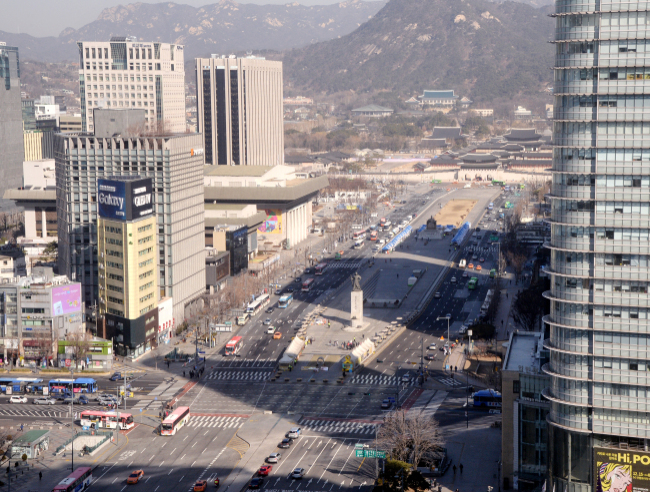Traffic volume in central Seoul area -- which includes the famous shopping district of Myeong-dong and the picturesque Gyeongbokgung palace -- will be reduced by 30 percent by 2030, by restricting the number of road lanes to a maximum of four and introducing a "toxicity charge," the Seoul Metropolitan Government said Tuesday.
The goal is to reduce the area’s greenhouse gas emissions by 40 percent, from the current 943,000 tons to 566,000 tons by 2030, the Seoul Metropolitan Government added.
Seoul City last year designated the 16.7 square kilometers of land within the Seoul City Wall as the first green transportation area, comprising some of the most famous tourist attractions in Seoul, including Gyeongbokgung palace, Jongmyo Shrine, the Gwanghwamun Plaza and Myeong-dong.
As the city government’s proposal to implement “green traffic” policies for the area has been approved by the Ministry of Land, Infrastructure and Transport, all major roads in the area, including Eulji-ro and Toegye-ro, will be restricted to a maximum of four lanes by 2030. Roads with bus lanes will be allowed to have a maximum of six lanes, the city government added.
 |
Seoul`s central city area near the Gyeongbokgung Palace. (Park Hyun-koo/The Korea Herald) |
At the same time, the metropolitan government aims to double the city’s bike lanes, as well as pedestrian friendly roads by 2030.
As part of its effort to prevent road fatalities in the designated area, the city plans to impose a speed limit of 50 kph for all main roads, and 30 kph for all small roads in residential zones, starting later this year.
Starting next year, the city also plans to run the designated central Seoul area as a Low Emissions Zone, where diesel vehicles with higher greenhouse emissions will be regulated. Those with vehicles that the Ministry of Environment considers “the most polluting” will either be banned from entering the area or will be asked to pay once in the area. The latter practice is commonly known as "toxicity charge" overseas.
Seoul residents had mixed reactions to the announcement. “The area is home to the headquarters of banks, conglomerates and tourist destinations. So many people commute to this area on a daily basis,” said a 36-year-old professional in Seoul, who only wanted to be identified by her last name Kim. She commutes to the central Seoul area from her home in southern Seoul every day.
“While I’m very concerned with the air quality in the city, I’m not sure if this will make my morning commute any better than it is now. Taking the Seoul Metro every morning is already pretty awful, it is very crowded, and with the new speed limit (of the vehicles on roads) I’m not sure what’s going to happen with public transportation.”
Another Seoul resident said while riding a bike is good for leisure and the environment, he feels that it is not suitable as a means of transportation in the city.
“I’m pretty sure most Seoulites feel the same way. Korea is not really suitable for bike riding, especially for commuters, as the weather tends to get quite extreme in summer and winter months,” said a Seoul resident in his 30s.
“Most employers don’t offer showers at the office. Imagine riding a bike to work during this heat wave. Your boss might ask you to go home.”
The new measures will influence those who live and work in eight areas in Seoul’s Jongno-gu district, including Sajik-dong, Samcheong-dong, Gahoe-dong, Ewha-dong, hyehwa-dong, and Jongno 1-6ga dong.
The new policies will also take effect in seven areas in the Jung-gu district. They are: Sogong-dong, Hoehyeon-dong, Myeong-dong, Pil-dong, Jangchung-dong and Euljiro-dong.
By Claire Lee (
dyc@heraldcorp.com)








![[Today’s K-pop] Blackpink’s Jennie, Lisa invited to Coachella as solo acts](http://res.heraldm.com/phpwas/restmb_idxmake.php?idx=644&simg=/content/image/2024/11/21/20241121050099_0.jpg)